- Foundation and Subsequent Progress of the Asian Shoulder Association
- Development of the Asian Shoulder and Elbow Association Since the 2011 Meeting in Japan
Foundation and Subsequent Progress of the Asian Shoulder Association
Japan Shoulder Society
Councilor
Hiroaki Tsutsui
Nineteen years after the establishment of the Japan Shoulder Society in 1974, the Asian Shoulder Association was established in 1993. (Fig. 1)
-
 Figure 1. Logo of the Asian Shoulder Association
Figure 1. Logo of the Asian Shoulder Association
The establishment of the Asian Shoulder Association during this period was motivated by several factors. The founding of International Congress of Shoulder Surgery (ICSS) in 1980, American Shoulder and Elbow Surgeons (ASES) in 1982, and European Society for Shoulder and Elbow Surgery (SECEC) in 1987 provided platforms for discussion of the shoulder on a global or continental scale. The emergence of such platforms worldwide or on continents likely prompted the desire for a similar forum in Asia (Table 1).
-
 Table 1. Shoulder Surgery Society in Japan
Table 1. Shoulder Surgery Society in Japan
The Japan Shoulder Society was the earliest shoulder research association worldwide. However, it wouldn't be an overstatement to say that the stimulating discussions at the "Shoulder-to-Shoulder Society," a gathering of people interested in shoulder surgery that started several years before the founding of the Japan Shoulder Society, paved the way for its establishment. At that time, for orthopedic surgeons in Asian countries, there weren't necessarily peers nearby akin to the "Shoulder-to-Shoulder Society" in Japan. Their only means of gathering ideas to address their questions about shoulder disorders was to attend international shoulder conferences in America or Europe and read the English literature. In this context, Dr. Katsuya Nobuhara paved the way for studying the shoulders of Asian orthopedic surgeons interested in shoulder surgery, overcoming economic constraints and language barriers, in 1970.
The number of exchange students accepted by Nobuhara Hospital since 1970 exceeded 100 in the following 40 years, spanning nine Asian countries. (Table 2)
-
 Table 2. List of Exchange Students at Nobuhara Hospital Over 42 Years
Table 2. List of Exchange Students at Nobuhara Hospital Over 42 Years
According to Dr. Katsuya Nobuhara in his book "Shoulder: Its Function and Clinical Aspects", the occasions where shoulder-related themes were addressed at academic conferences in Asian orthopedic surgery were limited to events such as the shoulder symposium at the 1st Annual Meeting of ASEAN Orthopedic Association held in Singapore in 1979 (President O R. Boon), and the Post Congress of International Shoulder Meeting organized by Kai-Ming Chan at the Hong Kong Orthopedic Association in 1988.
In 1992, the Western Pacific Orthopaedic Association (WPOA) held a conference in Indonesia under the presidency of Prof. Chehab Rukni Hilmy. During this conference, "Symposium Shoulder Day" was included in the program on the second day (see Reference 1). This symposium served as a catalyst for the establishment of the Asian Shoulder Association. However, why was this symposium included in the program?
-
 Reference 1. The 13th Annual Meeting of WPOA, Jakarta, Indonesia 1992, November 5th
Reference 1. The 13th Annual Meeting of WPOA, Jakarta, Indonesia 1992, November 5th
* Click on the image to see the PDF file
According to information obtained from Dr. Katsuya Nobuhara, the catalyst for the inclusion in this symposium was traced back to his visit to the Central Military Hospital in Jakarta in 1965. Dr. Nobuhara was accompanied by Dr. Daiji Kashiwagi, the first professor at Kobe University, and Dr. Kazushi Hirohata, who later became the second professor. (Fig. 2) During this visit, an offer for exchange studies was extended from Indonesia. In 1970, Dr. Misban Suharto became the first exchange student to undergo training at Nobuhara Hospital. Dr. Nobuhara revisited Jakarta in 1975, where he reunited with Dr. Misban Suharto. (Fig. 3) It was during this visit that Dr. Nobuhara met Prof. Chehab Rukni Hilmy, which seems to have initiated their acquaintance. (Fig. 4) Subsequently, they developed friendships, and when Professor Chehab Rukni Hilmy organized the WPOA meeting, he consulted Dr. Nobuhara. It was their mutual desire to include a symposium on shoulder surgery in the program for some time. Thanks to Prof. Chehab Rukni Hilmy's invitation, along with Dr. Ryuji Yamamoto, I participated in the symposium. (Fig. 5)
-
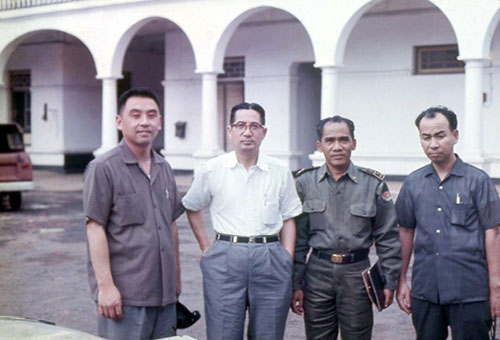 Figure 2. Visit to Jakarta in 1965, which became the catalyst for accepting exchange students from Indonesia. From right to left: Dr. Kazushi Hirohata (then Assistant Professor), Colonel Suyoto (later promoted to Surgeon General), Prof. Daiji Kashiwagi, and Dr. Katsuya Nobuhara.
Figure 2. Visit to Jakarta in 1965, which became the catalyst for accepting exchange students from Indonesia. From right to left: Dr. Kazushi Hirohata (then Assistant Professor), Colonel Suyoto (later promoted to Surgeon General), Prof. Daiji Kashiwagi, and Dr. Katsuya Nobuhara.
-
 Figure 3. Reunion with Mr. Sukaran in Jakarta in 1975. From right to left: Chief Administrator of Central Military Hospital, Lieutenant Colonel Suharto (the first exchange student), and Dr. Katsuya Nobuhara.
Figure 3. Reunion with Mr. Sukaran in Jakarta in 1975. From right to left: Chief Administrator of Central Military Hospital, Lieutenant Colonel Suharto (the first exchange student), and Dr. Katsuya Nobuhara.
-
 Figure 4. Mr. and Mrs. C.R. Hilmy, and Dr. Katsuya Nobuhara in 1975.
Figure 4. Mr. and Mrs. C.R. Hilmy, and Dr. Katsuya Nobuhara in 1975.
-
 Figure 5. Dr. Katsuya Nobuhara and Dr. Ryuji Yamamoto comparing the length of their arms in front of their wives.
Figure 5. Dr. Katsuya Nobuhara and Dr. Ryuji Yamamoto comparing the length of their arms in front of their wives.
After the symposium, shoulder surgeons from the participating countries held a meeting where they agreed to convene a committee for the establishment of the Asian Shoulder Association at the next year's Japan Shoulder Society meeting. (Fig. 6)
In 1993, the 20th Annual Meeting of the Japan Shoulder Society under the presidency of Dr. Nobuyuki Ito was scheduled to be held in Nagasaki. Prior to this, Drs. Nobuyuki Ito and Katsuya Nobuhara exchanged letters. (Reference 2).
Under Dr. Nobuyuki Ito’s chairmanship, a session titled ‘Asian Now’ was organized on the second day, featuring presentations from six speakers from the Philippines, China, Hong Kong, Australia, and Malaysia. (Table 3)
-
 Reference 2. Correspondence between Dr. Nobuyuki Ito and Dr. Katsuya Nobuhara
Reference 2. Correspondence between Dr. Nobuyuki Ito and Dr. Katsuya Nobuhara
* Click on the image to see the PDF file -
 Reference 3.
Reference 3.
* Click on the image to see the PDF file
-
 Table 3. "Asian Now" Session
Table 3. "Asian Now" Session
-
 Figure 6. Meeting in Jakarta towards the establishment of the Asian Shoulder Association
Figure 6. Meeting in Jakarta towards the establishment of the Asian Shoulder Association
After the conference, representatives from 11 regions—Australia, China, Hong Kong, Indonesia, Japan, South Korea, Malaysia, the Philippines, Singapore, Taiwan, and Thailand–totaling 19 individuals (Table 5) convened in Nagasaki to hold a committee meeting. Dr. Katsuya Nobuhara was elected president; thus, the Asian Shoulder Association was officially established. (Fig. 7)
Among the Founding Board Members, a consensus arose that it was important to promote shoulder surgery in developing Asian countries. It was agreed that holding academic conferences in regions outside Japan would be essential to pique the interests of orthopedic surgeons in those areas of shoulder surgery. As a result, it was decided that the first academic conference would be chaired by Jiunn-Jer Wu from Taiwan and would be held in Taipei the following year in 1994. (Fig. 8)
Furthermore, there was an opinion from Japanese members that Japan, being organizationally and financially robust, should support the Asian Shoulder Association. However, at that time, the Japan Shoulder Society took the stance that since the activities of the Asian Shoulder Association were personally undertaken by Dr. Katsuya Nobuhara, they would not provide support. Throughout the 40-year history leading to the evolution of the Japan Shoulder Society, there has been no active financial support, nor have there been any proactive efforts to report on the activities of the Asian Shoulder Association at the Japan Shoulder Society's executive meetings or promote them among its members.
Faced with a situation where financial and human support from the Japan Shoulder Society was not forthcoming, the Japanese Founding Board Members established the "Asian Shoulder Association Japan Club" in 1993 to create an organizational and financial support structure. At this time, approximately 100 members of the Japan Club, which supported the Asian Shoulder Association, were involved.
-
 Table 4. Founding Board members
Table 4. Founding Board members
-
 Figure 7. At the Japan Shoulder Society meeting in Nagasaki chaired by Dr. Nobuyuki Ito, from left to right: Dr. Katsuya Nobuhara and his wife, Dr. Ryuji Yamamoto, Dr. J.J. Wu and his wife, Dr. Nobuyuki Ito (president), and Dr. Kai-Nan An.
Figure 7. At the Japan Shoulder Society meeting in Nagasaki chaired by Dr. Nobuyuki Ito, from left to right: Dr. Katsuya Nobuhara and his wife, Dr. Ryuji Yamamoto, Dr. J.J. Wu and his wife, Dr. Nobuyuki Ito (president), and Dr. Kai-Nan An.
-
 Figure 8. Group photo after the meeting for the establishment of the Asian Shoulder Association. Front row, from left: K.M. Chan (Hong Kong), M. Sakurai (Japan), C.R. Hilmy (Indonesia), K. Nobuhara (Japan), J.J. Wu (Taipei, Taiwan), C.H. Feng (Beijing, China), N. Itoh (Japan). Back row, from left: V. Rojvanit (Bangkok, Thailand), H. Tsutsui (Japan), V.P. Kumar (Singapore), P. Hales (Perth, Australia), N. Subramanian (Kuala Lumpur), R. Yamamoto (Japan), P.H. Chien (Shanghai, China), G.Y. Huang (Beijing, China), L.M. Abrahan (Manila), A.A. Riera (Manila).
Figure 8. Group photo after the meeting for the establishment of the Asian Shoulder Association. Front row, from left: K.M. Chan (Hong Kong), M. Sakurai (Japan), C.R. Hilmy (Indonesia), K. Nobuhara (Japan), J.J. Wu (Taipei, Taiwan), C.H. Feng (Beijing, China), N. Itoh (Japan). Back row, from left: V. Rojvanit (Bangkok, Thailand), H. Tsutsui (Japan), V.P. Kumar (Singapore), P. Hales (Perth, Australia), N. Subramanian (Kuala Lumpur), R. Yamamoto (Japan), P.H. Chien (Shanghai, China), G.Y. Huang (Beijing, China), L.M. Abrahan (Manila), A.A. Riera (Manila).
The first Academic Congress of the Asian Shoulder Association (ACASA) was held in Taipei in 1994. Dr. Jiunn Jer Wu, the congress chairman, invited numerous specialists from Europe, America, and other Asian countries. A total of 250 people participated in this academic congress, including 80 from Japan. With 83 presentations, the Congress aimed not only to advance scholarly pursuits but also to foster camaraderie, marking the beginning of a scholarly gathering dedicated to advancing shoulder joint research in Asia. (Figs 9-11 and 12)
-
 Figure 9. The 1st ACASA in Taipei, Taiwan (R.O.C.) in 1994.
Figure 9. The 1st ACASA in Taipei, Taiwan (R.O.C.) in 1994.
-
 Figure 10. Presentation of a commemorative gift from President Dr. Katsuya Nobuhara to the first Academic Congress Chairman.
Figure 10. Presentation of a commemorative gift from President Dr. Katsuya Nobuhara to the first Academic Congress Chairman.
-
 Figure 11. Karaoke competition at the President's banquet.
Figure 11. Karaoke competition at the President's banquet.
-
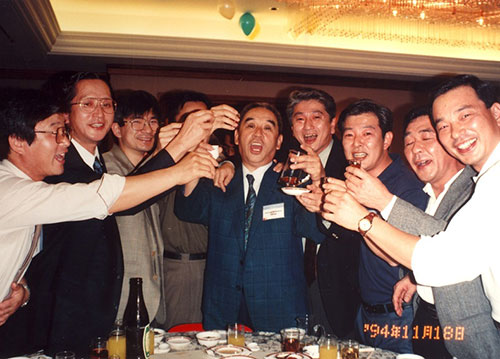 Figure 12. Young Lions at the President's banquet.
Figure 12. Young Lions at the President's banquet.
The second congress (1996) was chaired by Peter Hales and took place in Perth, Australia, with 71 presentations. Of the 120 participants from Japan, the total number of attendees was 450. (Figs 13-16 and 17)
-
 Figure 13. The 2nd ACASA in Perth, Australia, in 1996.
Figure 13. The 2nd ACASA in Perth, Australia, in 1996.
-
 Figure 14. In a park near the venue.
Figure 14. In a park near the venue.
-
 Figure 15. In town, from right to left: Dr. Kenji Takagishi, Dr. Nobuyuki Ito, Dr. Kiyohisa Ogawa, Dr. Hiroaki Tsutsui.
Figure 15. In town, from right to left: Dr. Kenji Takagishi, Dr. Nobuyuki Ito, Dr. Kiyohisa Ogawa, Dr. Hiroaki Tsutsui.
-
 Figure 16. At the social gathering, from right to left: Dr. Kenji Takagishi, Dr. Kimitaka Fukuda, Stephen Liu (UCA), Dr. Hiroaki Tsutsui, Dr. Kie Nobuhara, Dr. Kou Mimura, Dr. Nobuyuki Ito, QY Xue (Beijing Hospital), Dr. Kiyohisa Ogawa.
Figure 16. At the social gathering, from right to left: Dr. Kenji Takagishi, Dr. Kimitaka Fukuda, Stephen Liu (UCA), Dr. Hiroaki Tsutsui, Dr. Kie Nobuhara, Dr. Kou Mimura, Dr. Nobuyuki Ito, QY Xue (Beijing Hospital), Dr. Kiyohisa Ogawa.
-
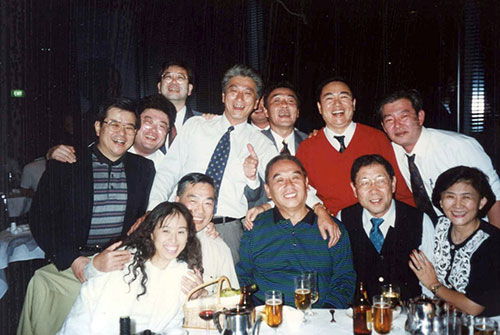 Figure 17. At the social gathering, front row from right to left: Dr. Ryuju Yamamoto and his wife, Dr. Katsuya Nobuhara, G.Y. Huang (Beijing, China), Dr. Kie Nobuhara. Back row from right to left: Dr. Kenji Takagishi, QY Xue (Beijing, China), Dr. Kiyohisa Ogawa, Dr. Hiroaki Tsutsui, Dr. Jun Hashimoto, Dr. Yuichiro Yamazaki, Dr. Jun Kumagai.
Figure 17. At the social gathering, front row from right to left: Dr. Ryuju Yamamoto and his wife, Dr. Katsuya Nobuhara, G.Y. Huang (Beijing, China), Dr. Kie Nobuhara. Back row from right to left: Dr. Kenji Takagishi, QY Xue (Beijing, China), Dr. Kiyohisa Ogawa, Dr. Hiroaki Tsutsui, Dr. Jun Hashimoto, Dr. Yuichiro Yamazaki, Dr. Jun Kumagai.
A request to join the Journal of Shoulder and Elbow Surgery (JSES) was received from Prof. Otto Sneppen, the editor-in-chief of JSES. This marked our association’s recognition as a member of the international academic community.
On March 16, 1998, the JSES Board of Trustees officially approved the inclusion of the Asian Shoulder Association. Subsequently, the Asian Shoulder Association appointed KM Chan as the editor-in-chief and established an editorial board consisting of JJ Wu (Taiwan), Chehab R Hilmy (Indonesia), Gong-Yi Huang (China), Antonio A Rivera (Philippines), Vatanachai Rojvanit (Thailand), VP Kumar (Singapore), and Yong-Girl Rhee (South Korea). This allowed the acceptance of submissions from Asia.
The third congress (1999) was chaired by Chehab Rukni Hilmy and held in Bali, Indonesia. A week before the Academic Congress, street trees in Bali were set on fire by anti-government guerrillas, causing many potential attendees to hesitate. Although the number of participants from Japan decreased to 90, 400 attendees from 13 countries and regions were gathered, allowing for discussions centered around 49 presentations. (Figs 18, 19 and 20)
-
 Figure 18. The 3rd ACASA in Bali, Indonesia, in 1999.
Figure 18. The 3rd ACASA in Bali, Indonesia, in 1999.
-
 Figure 19. Board meeting.
Figure 19. Board meeting.
-
 Figure 20. Opening ceremony.
Figure 20. Opening ceremony.
The Fourth Congress (2002) was held in Seoul under Kwang-Jin Rhee’s presidency. The academic congress featured 88 presentations with 120 attendees from Japan among the 400 participants. Additionally, amid traffic congestion, various social events, including dinners in Seoul, facilitated camaraderie among the participants. (Figs 21-24 and 25)
-
 Figure 21. The 4th ACASA in Seoul, South Korea, in 2002.
Figure 21. The 4th ACASA in Seoul, South Korea, in 2002.
-
 Figure 22. Just before the opening ceremony, in the president's office at the Daejeon University, with Dr. Kwang-Jin Rhee, Dr. Katsuya Nobuhara, and Dr. Yong-Girl Rhee.
Figure 22. Just before the opening ceremony, in the president's office at the Daejeon University, with Dr. Kwang-Jin Rhee, Dr. Katsuya Nobuhara, and Dr. Yong-Girl Rhee.
-
 Figure 23. Venue of the Presidential banquet.
Figure 23. Venue of the Presidential banquet.
-
 Figure 24. Venue of the Presidential banquet.
Figure 24. Venue of the Presidential banquet.
-
 Figure 25. Dr. Kimitaka Fukuda, Dr. Hiroaki Tsutsui, Dr. Kwang-Jin Rhee, and Dr. Kiyohisa Ogawa.
Figure 25. Dr. Kimitaka Fukuda, Dr. Hiroaki Tsutsui, Dr. Kwang-Jin Rhee, and Dr. Kiyohisa Ogawa.
The fifth Congress (2005) was held in Beijing under the presidency of Gong-Yi Huang. The number of presentations was substantial, at 156. In Japan, 110 individuals participated, contributing to a total of 450 participants, a scale similar to that of the previous Congress in South Korea. (Figs. 26-30 and 31)
-
 Figure 26. The 5th ACASA in Beijing, China, in 2005.
Figure 26. The 5th ACASA in Beijing, China, in 2005.
-
 Figure 27. Presentation of a commemorative medal from President Katsuya Nobuhara to Academic Congress President G.Y. Huang.
Figure 27. Presentation of a commemorative medal from President Katsuya Nobuhara to Academic Congress President G.Y. Huang.
-
 Figure 28. Board Meeting.
Figure 28. Board Meeting.
-
 Figure 29. Commemorative photo of the Board Meeting.
Figure 29. Commemorative photo of the Board Meeting.
-
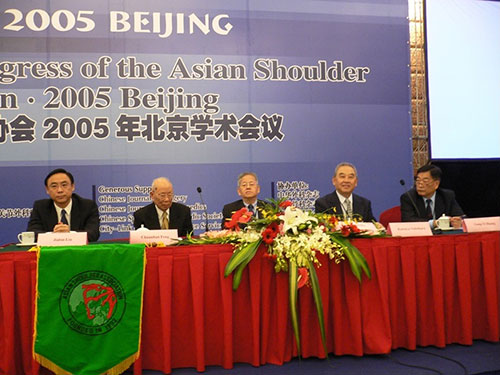 Figure 30. Opening ceremony of the academic congress.
Figure 30. Opening ceremony of the academic congress.
-
 Figure 31. Keynote lecture by Dr. Katsuya Nobuhara.
Figure 31. Keynote lecture by Dr. Katsuya Nobuhara.
The Sixth Congress (2009) was held in Hong Kong under the presidency of Kai-Ming Chan. However, as numerous academic sessions and training courses were held simultaneously, although there were 102 presentations, the number of participants was limited to 60 from Japan, with 300 attendees. (Figs. 32-34 and 35) During the Board meeting at this event, members from various countries requested that the congress be held in Japan next time, to which agreement was given before returning home.
-
 Figure 32. The 6th ACASA in Hong Kong in 2008.
Figure 32. The 6th ACASA in Hong Kong in 2008.
-
 Figure 33. Board Meeting at the dinner venue.
Figure 33. Board Meeting at the dinner venue.
-
 Figure 34. Board Meeting at the dinner venue.
Figure 34. Board Meeting at the dinner venue.
-
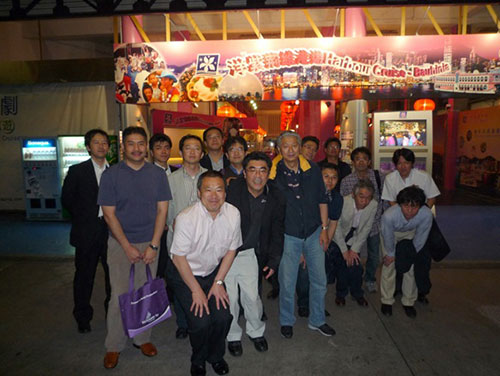 Figure 35. At the boarding point of the sightseeing boat for the night light-up tour.
Figure 35. At the boarding point of the sightseeing boat for the night light-up tour.
After returning home, Congress President Katsuya Nobuhara convened a meeting and Secretary-General Hiroaki Tsutsui discussed the next Congress. During the meeting, Dr. Nobuhara proposed that Dr. Tsutsui serve as Congress president and Hiroyuki Sugaya as the Secretary-General for the upcoming Congress. Subsequently, preparations began to be made at hotels around Disneyland.
A report titled “Organization and Progress of the 7th Asian Shoulder Association Congress” was presented at the board meeting of the Japan Shoulder Society for organizing the 7th Asian Shoulder Association Congress. While no financial support was requested from the Japan Shoulder Society during this presentation, they refused to provide a means of contacting members via email, which necessitated establishing independent communication networks. The Japanese Shoulder Society only agreed to have its name listed as a “supporting organization.”
Regarding the planning of the academic congress, it was aimed to make this event not only beneficial for participants from Japan but also for those from across Asia. The Congress was envisioned as a platform for making friends and understanding the research being conducted in different countries and by different researchers. To achieve this, the congress brochure included photos of all speakers, along with their abstracts, ensuring that even young researchers could connect and potentially build future collaborations. Additionally, considering the concurrent organization of the "Shoulder Movement Function Research Society" by the Japan Shoulder Society starting from the 31st academic congress, it was decided to hold the inaugural "Asian Congress of Shoulder & Elbow Therapist (ACSET)" simultaneously. This event, chaired by Dr. Teru Takahama, the Director of Kyushu Chuou Rehabilitation Gakuin, aimed to bring together physical therapists from across Asia.
However, this year, the Great East Japan Earthquake occurred on March 11, resulting in concerns about radioactive contamination from the Fukushima nuclear power plant and liquefaction in the Urayasu area where the venue was planned. Due to the difficult circumstances and anxiety among overseas participants, holding an academic congress at a hotel near Disneyland became challenging. Instead of rescheduling the event, it was hastily decided to change the venue to a hotel in Naha, Okinawa, while retaining the original date. Despite being held just four months after the Great East Japan Earthquake, the event concluded successfully with the participation of 80 attendees from overseas and 270 from Japan thanks to their collaboration and support.
The 1st Asian Congress of Shoulder and Elbow Therapists (ACSET), held concurrently, featured two keynote speeches and 72 presentations. However, it seems that the affairs and research of physical therapists were not widely recognized in Asia, as almost all participants, except for a few speakers, were from Japan. Expectations are high for future developments in this regard. (Figs. 36-39 and Table 5).
-
 Figure 38. Board Meeting
Figure 38. Board Meeting
-
 Figure 39. Group photo at the President's Banquet
Figure 39. Group photo at the President's Banquet
-
 Table 5. List of Number of Participants from the 1st ACASA to the 7th
Table 5. List of Number of Participants from the 1st ACASA to the 7th
On the other hand, concerning shoulder joints in Asia, the Korean Shoulder and Elbow Society was established in 1993, followed by the opening of the China Shoulder Center in Beijing in 1997. The Philippine Shoulder Society was founded in the same year. Along with the momentum of the establishment of the Asian Shoulder Association, enthusiasm for organizing academic congresses in various countries and regions of Asia has been growing. Additionally, as shown in Table 5, the participants of each academic congress came from countries other than Japan, indicating that this approach has contributed to the development of shoulder surgery in various countries and regions to some extent.
In particular, the Korean Shoulder and Elbow Society, established in 1993 (Table 6 and Fig. 40), has actively sent shoulder surgeons of president-level caliber to countries such as Japan, Europe, and the United States to study abroad. They also demonstrated a proactive attitude toward participating in exchanges with Japan (Fig. 41), leading to the steady expansion and improvement of the organization. Subsequently, an exchange study system was established between the Korean Shoulder and Elbow Society and Japan Shoulder Society (Table 7). Moreover, a system was created that allowed mutual participation and open exchanges of questions and answers at academic congresses. Exchange students were also selected from these two countries for exchanges with SECEC and ASES, visiting together under the exchange study system within Asia.
-
 Table 6. List of Founding Members and Presidents of KSES
Table 6. List of Founding Members and Presidents of KSES
-
 Table 7. Traveling fellows between JSS and KSES
Table 7. Traveling fellows between JSS and KSES
-
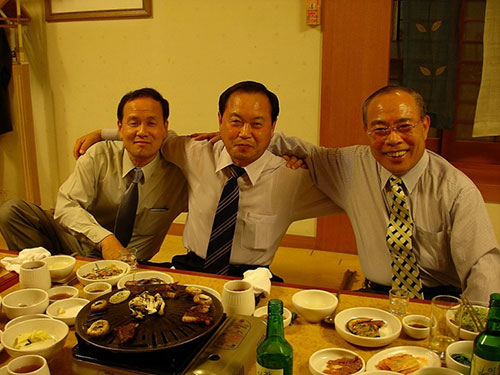 Figure 40. Photo from the establishment of KSES
Figure 40. Photo from the establishment of KSES
Eun-Sun MOON (10th), Kwang-Jin Rhee (4th), Kwon-Ick Ha (1st), This photo was provided by Prof. Jin-Young PARK
-
 Figure 41. At the 50th KOA (October 18, 2006), the presidents of KSES organized a dinner.
Figure 41. At the 50th KOA (October 18, 2006), the presidents of KSES organized a dinner.
Front row from left: Sung-Jae Kim (9th), Kwang-Jin Rhee (4th), Hiroaki Tsutsui and Kwon-Ick Ha (1st), and Yong-girl Rhee (13th and 14th). Back row from left: Ken Yamaguchi, Daisuke Makiuchi, Tae-Soo Park (15th), Ki-Yong Byun, Jung-Man Kim (6th), Jin-Young Park (18th).
I sincerely hope that the "Asian Shoulder Association" will continue to thrive as an organization that provides members with clinical and research opportunities across various regions of Asia, fosters mutual exchange among members, and contributes as a significant entity representing one of the five continents within a global framework.
Finally, I express my gratitude for being involved with the Asian Shoulder Association for over 20 years since its inception. I also recognize the importance of the Japan Shoulder Society's international activities in grounding its own level of expertise within the international community and fulfilling its role in promoting shoulder education and dissemination throughout Asia. I hope that through proactive engagement we can achieve further development.
Last, heartfelt thanks go to the spouses who quietly supported our activities. (Fig. 42)
-
 Figure 42. From left to right - Mrs. Katsuya Nobuhara, Mrs. Motohiko Mikasa, Mrs. Tomomitsu Kutsuma, Mrs. Hiroaki Tsutsui, Mrs. Ryuji Yamamoto, and in the back row from left to right - Katsuya Nobuhara, and Mrs. Shiro Tabata.
Figure 42. From left to right - Mrs. Katsuya Nobuhara, Mrs. Motohiko Mikasa, Mrs. Tomomitsu Kutsuma, Mrs. Hiroaki Tsutsui, Mrs. Ryuji Yamamoto, and in the back row from left to right - Katsuya Nobuhara, and Mrs. Shiro Tabata.

 Figure 36. Cover Page and Presidential Message of the 7th ACASA, 2011
Figure 36. Cover Page and Presidential Message of the 7th ACASA, 2011 Figure 37. Committee Members of the 7th ACASA
Figure 37. Committee Members of the 7th ACASA